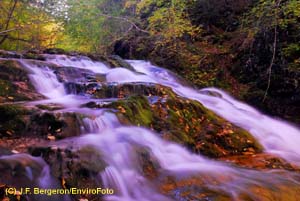
Soils and Water
 Timber harvesting and forest management may significantly impact water and soil at both operational and landscape scales. Nova Scotia's Code of Forest Practice states that forest management will be designed and conducted in a manner that maintains and enhances the quality of air, water, and soil. Access roads, harvesting equipment, pesticides, and vegetation change, may all directly and indirectly affect nutrient budgets, soil structure, moisture regimes, erosion, sedimentation, and hydrological systems. A wide range of regulations, management tools, and research helps protect these resources.
Timber harvesting and forest management may significantly impact water and soil at both operational and landscape scales. Nova Scotia's Code of Forest Practice states that forest management will be designed and conducted in a manner that maintains and enhances the quality of air, water, and soil. Access roads, harvesting equipment, pesticides, and vegetation change, may all directly and indirectly affect nutrient budgets, soil structure, moisture regimes, erosion, sedimentation, and hydrological systems. A wide range of regulations, management tools, and research helps protect these resources.
Research Reports
Nova Scotia's Code of Forest Practice
A Framework for the Implementation of Sustainable Forest Management outlines the principles for management. Guidelines for Crown Lands provides guidance for forest ecosystems. Forest products, wildlife habitat, and integrated forest use.
Watercourse and Wildlife Habitat Protection Regulations
These regulations apply to all lands, Crown and private, and have three major requirements: leaving buffer strips along watercourses, leaving legacy trees in clumps, and leaving coarse woody debris in all types of forest harvesting and management activities.
Forest Ecosystem Classification
In 2010, results from 10 years of FEC project work were synthesized to produce a comprehensive provincial FEC guide which is presented in three documents: Forest Ecosystem Classification for Nova Scotia: Part I Vegetation Types (2010); Part II Soil Types (2010); and Part III Ecosites (2010). This three-part guide builds upon, but also supersedes, all earlier FEC publications.
Pockwock-Bowater Watershed Study
This multi-partner research project focussed on measuring watershed responses to forest harvesting and riparian zone treatments. The wide range of reports produced inform the forest hydrology model ForHyM developed at the Nexfor-Bowater Forest Watershed Research Centre located at the University of New Brunswick.
Wet Areas Mapping
Ecologically diverse and management sensitive sites can be identified in the Wet Areas Mapping project.
Quantifying Ground Disturbance and Soil Compaction After Forest Harvesting (to be published)
Forest Ecosystem Classification for Nova Scotia Part II: Soil Types (2010)
Links to other Department Programs
Nova Scotia Department of the Environment - Air, Land and Water